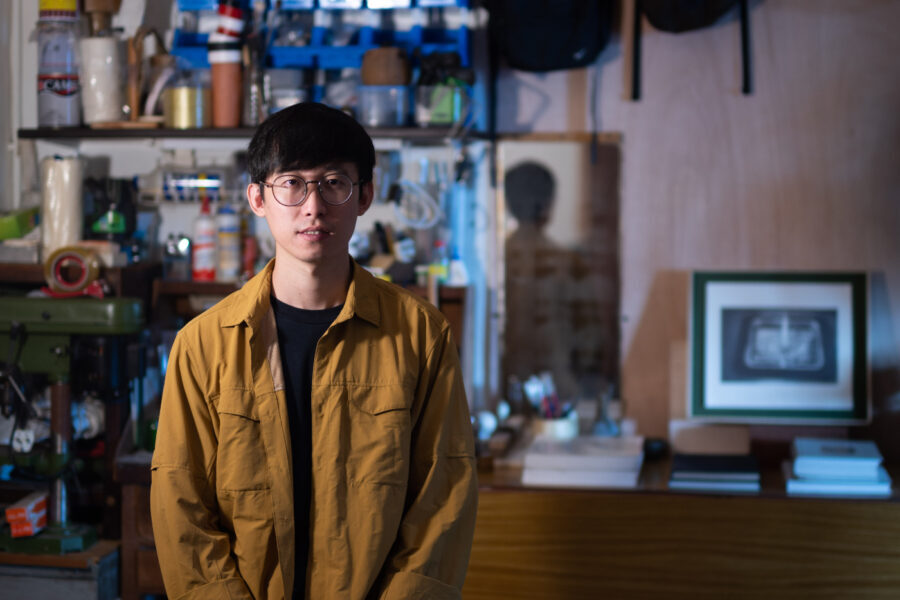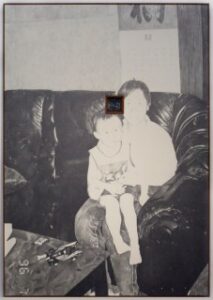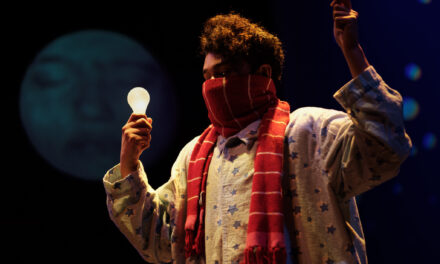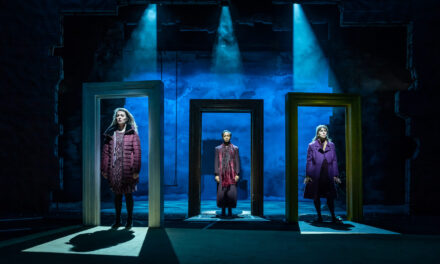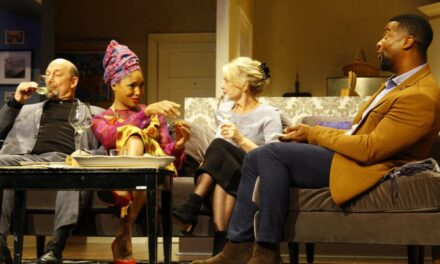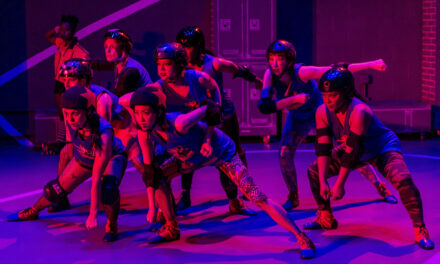When Tang Kwong-san and fellow Hong Kong artist Yuen Nga-chi first visited Tung Ping Chau a few months ago, they were looking for an interesting backdrop for a project they had in mind. But the visit made the artists realise the island deserved to be its own protagonist.
Located in Mirs Bays, more than 10 kilometres off the far northeastern coast of Hong Kong, Tung Ping Chau was considered a midway resting point for so-called “freedom swimmers” escaping Chinese Communist rule during the 1970s. Many of these swimmers drowned at sea, their bodies subsequently washing up on the shores of the island. On the ferry to the island, Tang had overheard a group of Chinese “aunties” recounting the island’s grim history. As soon as the ferry docked the pier, however, all appeared to be forgotten. “They started happily posing, taking photos,” recalls the artist, who saw a certain absurdity in the scene unfolding before him.
This absurdity provided Tang with the perfect entry point to explore the politically fraught history of the island—and indeed of Hong Kong itself—in a series of videos and installations that are exhibited in Landing in the East, at the Diana Keng Experimental Gallery in the Hong Kong Arts Centre. In the exhibition, footage from Tang’s trips to the island explores ideas of identity and displacement, as well as that of image-making itself. One work on display is a long-shot negative footage of the aunties, their blurred faces and bodies melding with the sedimentary rocks for which Tung Ping Chau is famous.
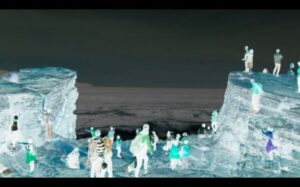

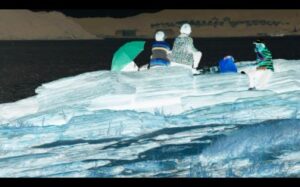
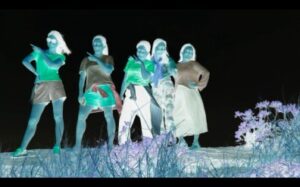
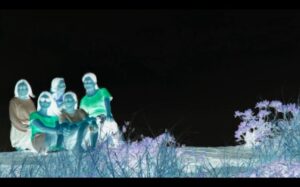
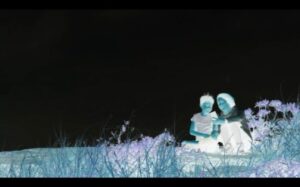
Tang’s own journey to Hong Kong was much less grueling. Born in 1992 in Dongguan, halfway between Hong Kong and Guangzhou, he arrived here with his father and brother at the age of five. His mother followed five years later. If he had left a decade later, he would probably be hyper-aware of his diasporic identity. But for Tang, too young to have that awareness at the time, it was the temporary separation from his mother that would end up having a huge impact on his work. “There was this sense of emptiness and displacement,” he says. “It didn’t help that my dad was this traditional Chinese father figure. We didn’t communicate that much. I was definitely much closer to my mother.”
Tang’s mother passed away when he was at university. When he took her ashes home to Dongguan, he discovered a treasure trove of photo albums he had never seen before. “When I was younger, I had always wondered, why are there so few photos of my childhood? It turns out they were all kept in China.”
That sense of loss seeps through his works, from the literal gaps in paintings to deliberately blurred faces. Tang, who has an undergraduate degree in fine arts co-presented by the Hong Kong Art School and the Royal Melbourne Institute of Technology, has very specific ideas of what he wants to achieve through his graphite drawings and oil paintings. He studied oil painting but turned to graphite drawing when he was navigating the pain of his mother’s death. He speaks about giving himself the time to “experience the image” for “’96 7 14,” a piece first exhibited at Hidden Space in 2019, and is now on show at Whitestone’s Space and Memory group exhibition.
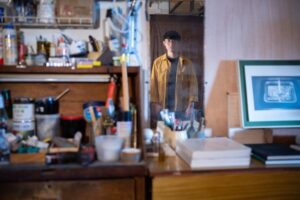
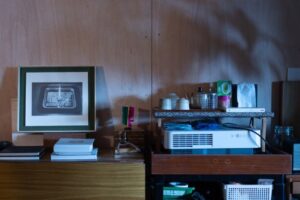
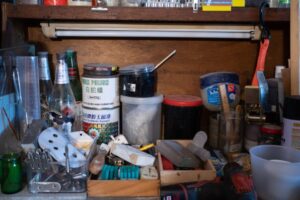
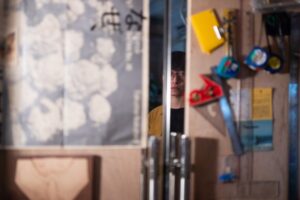
At the centre of the work is a tiny frame, and nestled within is a negative copy of an illustration of an older women and a younger child, lifted from a children’s book found in Tang’s Dongguan home. By installing a found image atop the drawing, it seems like Tang is trying to draw further attention to its artificial nature – that it isn’t merely a copy of a photograph, but his reconstruction of a specific time and space from the past.
Such reverberations of the past are also seen in “Diaspora I,” also on display at Whitestone. A tea-coloured film is installed in front of drawings of scenes from Bamboo Curtain, a 1978 BBC documentary about the swimmers braving torrential seas to escape Communist rule. The film blurs the swimmers’ faces and documentary narrative, yet also brings to mind the fibreglass windows separating government officials and applicants at immigration offices, bringing a sense of the present to the work, as if its viewers are waiting in line to apply for visas.
The artist says he had finally laid his grief to rest two years after his mother’s death. But ideas of displacement continue to feature prominently in his art. After all, many Hongkongers are going through similar experiences, with many departing the city after the passing of the National Security Law last July. Tang will never truly be able to understand what the illegal immigrants in the BBC documentary went through, but he could situate himself in similar moments in time.
Nightbirds at Gallery Exit, which ran from May 15 to June 19 this year, brings some of that thinking to the fore. The exhibition has multiple reference points, including the macabre tale behind the nursery rhyme “London Bridge is Falling Down,” as well as Nothing to Envy: Ordinary Lives in North Korea, a book documenting the lives of six North Korean defectors. What transpired was a series of photographic prints, oil paintings and objects. On the walls are photographic prints of the inside pages of the book, and paintings of discarded objects Tang picked up on the streets. Amidst it all, pottery bird figures drown in a water tank.
“I think history is really a never-ending loop,” says Tang. “It just happens that the big moment in history [is] in Hong Kong, right now.” He says the North Korean defectors and the children buried under London Bridge both made him think of the situation here. “Especially the city’s youths,” he says. “How their futures are being sacrificed.”
One of the works in Landing in the East is a video piece that knits together images of found objects from Tung Ping Chau with commemorative items from the 1997 handover, including a monopoly game, an image of Tsing Ma Bridge, commemorative coins and the Chinese white dolphin. The artist collected them from second hand marketplaces. It’s a contrast of old and new, decay and celebratory, the images on left giving those on the right a dose of wistfulness.
“The Chinese white dolphin was such a strong symbol of Hong Kong. It was in all the school books,” says Tang. But what represents Hong Kong now? Perhaps the plants and furniture piling up inside trash collection points. For the artist, they are objects with their own history, scars and sentimentality. Tang says he’d like to keep painting them. “I think it’s especially interesting now, with so many leaving the city. You see what people leave behind when they leave a place.”
Space and Memory runs until September 30 at Whitestone Gallery, Central. Landing on the East runs until October 01, 2021 at Hong Kong Arts Centre, Wan Chai.
This article was originally created by Christie Lee posted by Zolima City Mag on September 15, 2021 and has been reposted with permission. To read the original article, click here.
This post was written by the author in their personal capacity.The opinions expressed in this article are the author’s own and do not reflect the view of The Theatre Times, their staff or collaborators.
This post was written by Zolima CityMag.
The views expressed here belong to the author and do not necessarily reflect our views and opinions.

